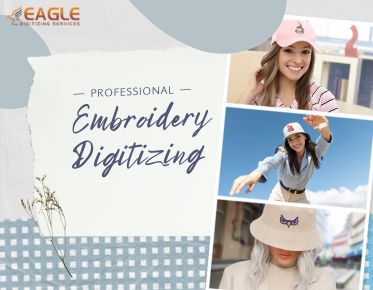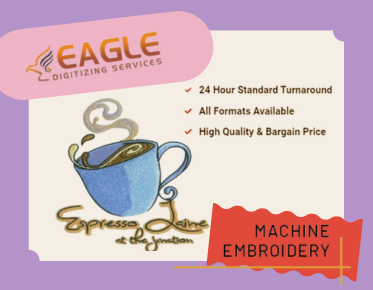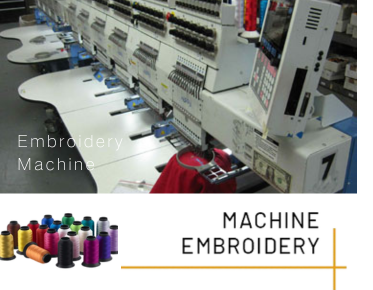Explore Single Head Embroidery Machines: Your Complete Overview from Eagle Digitizing
Embroidery has long been celebrated as a sophisticated art form, transforming plain fabrics into intricate masterpieces. At the heart of this craft lies the embroidery machine, a marvel of technology that has revolutionized the way we create embroidered designs. One standout type in the vast array of embroidery machines is the single-head embroidery machine. Compact yet powerful, it caters to both novice hobbyists and seasoned professionals, making it a staple in the embroidery world.
Understanding Embroidery Machines
Embroidery machines are specialized devices designed to automate the process of embroidery. Unlike manual embroidery, which requires painstaking effort and time, these machines can replicate complex designs with precision and speed. They are equipped with a variety of features that allow users to create detailed and consistent embroidery patterns on different types of fabrics.
History of Embroidery Machines
The journey of embroidery machines dates back to the Industrial Revolution. The first mechanical embroidery machine was invented by Joshua Heilmann in 1828. This rudimentary machine laid the foundation for future advancements. Over the years, these machines evolved from manually operated devices to sophisticated computerized systems, reflecting technological progress and changing consumer needs.
Modern Advancements in Embroidery Technology
Today, embroidery machines boast cutting-edge technology that enhances efficiency and creativity. Features like digital touchscreens, USB connectivity, and automatic thread cutting have transformed embroidery into a seamless process. Modern machines also support a wide range of embroidery formats, making it easier to import and edit designs.
Types of Embroidery Machines
Embroidery machines come in various types, each catering to specific needs. Multi-head machines are used in large-scale production, allowing multiple designs to be embroidered simultaneously. On the other hand, single-head embroidery machines are perfect for smaller operations, offering flexibility and ease of use without compromising on quality.
Defining Single-Head Embroidery Machines
Single-head embroidery machines are characterized by having one embroidery head that can handle multiple needles. This setup allows for the creation of intricate designs with multiple colors. They are versatile and can be used for both small-scale commercial purposes and personal projects.
Key Features of Single-Head Embroidery Machines
Compact Size and Portability
One of the standout features of single-head embroidery machines is their compact size. Unlike their multi-head counterparts, they occupy less space, making them ideal for small workshops or home studios. Their portability also allows users to transport them easily, facilitating on-site embroidery services.
Ease of Use for Beginners and Professionals
These machines are designed with user-friendliness in mind. They come equipped with intuitive interfaces and automated features that simplify the embroidery process. Beginners can quickly learn the basics, while experienced professionals can take advantage of advanced functions to refine their craft.
Versatility in Embroidery Designs
Single-head embroidery machines are incredibly versatile. They can handle a wide range of designs, from simple monograms to elaborate patterns. This versatility makes them suitable for various applications, including apparel, accessories, and home décor.
Components of a Single-Head Embroidery Machine
Embroidery Hoop
The embroidery hoop is a crucial component that holds the fabric in place during the embroidery process. It ensures that the fabric remains taut, allowing for precise stitching. Different hoop sizes are available to accommodate various design dimensions.
Needle and Thread System
The needle and thread system is the core of any embroidery machine. Single-head machines typically have multiple needles, each capable of holding a different color thread. This setup allows for seamless color changes within a design, enhancing efficiency and reducing manual intervention.
Control Panel and Software
Modern single-head embroidery machines feature a digital control panel that allows users to select and customize designs. The accompanying software provides additional functionalities, such as design editing and resizing. These tools empower users to bring their creative visions to life with ease.
Benefits of Using a Single-Head Embroidery Machine
Perfect for Small Businesses and Hobbyists
Single-head embroidery machines are a boon for small businesses and hobbyists. They offer professional-quality embroidery without the hefty price tag of industrial machines. This affordability, combined with their high performance, makes them an excellent investment for startups and individual crafters.
Cost-Effective Solution
Compared to multi-head machines, single-head embroidery machines are more cost-effective. They require less maintenance and consume less power, resulting in lower operational costs. This makes them an attractive option for those looking to manage expenses without compromising on quality.
Flexibility in Design Creation
The flexibility offered by single-head embroidery machines is unparalleled. Users can experiment with different designs and materials, expanding their creative horizons. Whether it’s a one-off custom piece or a small batch of identical items, these machines can handle it all with aplomb.
Applications of Single-Head Embroidery Machines
Custom Apparel and Accessories
Single-head embroidery machines excel in creating custom apparel and accessories. From personalized t-shirts and hats to bespoke bags and scarves, the possibilities are endless. They allow businesses to offer unique, high-quality products that stand out in a competitive market.
Promotional Products
Promotional products are another area where single-head embroidery machines shine. Companies can use them to create branded merchandise, such as embroidered logos on shirts, caps, and bags. These items serve as effective marketing tools, enhancing brand visibility and customer loyalty.
Home Décor and Crafts
Home décor enthusiasts and crafters can also benefit from single-head embroidery machines. They can be used to embellish items like cushions, curtains, and table runners, adding a personal touch to home interiors. Additionally, they are perfect for creating handmade gifts and craft projects.
How to Choose the Right Single-Head Embroidery Machine
Considering Your Budget
When choosing a single-head embroidery machine, budget is a crucial factor. It is critical to find a balance between cost and functionality. While opting for the most affordable option is tempting, investing in a slightly higher-end model can provide better performance and longevity.
Evaluating Machine Features and Capabilities
Assessing the features and capabilities of different models is essential. Look for machines that offer a good range of built-in designs, multiple needle options, and user-friendly interfaces. Advanced features like automatic thread tension adjustment and real-time monitoring can significantly enhance your embroidery experience.
Reading Reviews and Seeking Recommendations
Before making a purchase, it’s wise to read reviews and seek recommendations from other users. Online forums and social media groups dedicated to embroidery can provide valuable insights into the pros and cons of various models. Personal testimonials and success stories can also guide you in making an informed decision.
Setting Up Your Single-Head Embroidery Machine
Initial Assembly and Installation
Setting up a single-head embroidery machine involves a few initial steps. Begin by constructing the machine following the manufacturer's directions. Ensure that all parts are securely fitted and that the machine is placed on a stable surface. Proper installation is crucial for optimal performance.
Software and Design Setup
Once the machine is assembled, the next step is to install the accompanying software. This software allows you to import and customize designs. Familiarize yourself with its features and functions to make the most of your embroidery projects. Experiment with different designs to get a feel for the machine’s capabilities.
Maintenance Tips and Tricks
Regular maintenance is key to keeping your embroidery machine in top condition. Clean the machine after each use to remove lint and dust. Lubricate moving parts as recommended by the manufacturer to prevent wear and tear. Regularly check and replace needles to ensure smooth operation.
Popular Brands and Models
Top Single-Head Embroidery Machines on the Market
There are several reputable brands that manufacture single-head embroidery machines. Brands like Brother, Janome, and Bernina are known for their high-quality machines that offer excellent performance and durability. Each brand offers a range of models with varying features, catering to different needs and budgets.
Comparing Features and Prices
When comparing different models, consider both features and prices. Some machines may offer advanced features at a higher price point, while others provide basic functionalities at a more affordable cost. Make a list of your must-have features and compare them against the available options to find the best fit for your needs.
Success Stories and Testimonials
Many users have achieved remarkable success with single-head embroidery machines. From small business owners who’ve expanded their product lines to hobbyists who’ve honed their skills, these machines have played a pivotal role in their journeys. Testimonials highlight the ease of use, versatility, and reliability of these machines, making them a popular choice among embroidery enthusiasts.
Tips for Mastering Single-Head Embroidery
Practice Makes Perfect
As with any skill, practice is essential for mastering embroidery. Start with simple designs and gradually move on to more complex patterns. Regular practice will help you become familiar with the machine’s functions and improve your precision and speed.
Exploring Different Embroidery Techniques
Embroidery offers a wide array of techniques to explore. From satin stitches and French knots to appliqué and cutwork, each technique adds a unique touch to your designs. Experimenting with different techniques will enhance your creativity and expand your repertoire.
Troubleshooting Common Issues
Encountering issues is part of the learning process. Common problems like thread breaks, puckering, and misalignment can be frustrating, but they are often easily resolved. Consult your machine’s manual, seek advice from online forums, or watch tutorial videos to troubleshoot and fix these issues.
Future Trends in Embroidery Technology
Innovations on the Horizon
The world of embroidery technology is continuously evolving. Innovations such as AI-driven design software, smart fabric sensors, and advanced stitching algorithms are set to revolutionize the industry. These advancements promise to make embroidery more intuitive, efficient, and accessible to a broader audience.
How Single-Head Machines Are Evolving
Single-head embroidery machines are also undergoing significant advancements. New models are incorporating features like wireless connectivity, enhanced touchscreen interfaces, and expanded memory capacity. These enhancements are aimed at providing users with greater convenience and creative freedom.
Embroidery is more than just a craft; it’s an art form that allows individuals to express their creativity and individuality. Eagle Digitizing offers embroidery digitizing services. Single-head embroidery machines play a crucial role in making this art accessible to everyone, from hobbyists to entrepreneurs.
Investing in a single-head embroidery machine can be a rewarding decision. It offers a perfect blend of affordability, functionality, and versatility. Whether you’re looking to start a small business or pursue a creative hobby, these machines provide the tools you need to succeed. Allow your imagination to soar as you embrace the craft of needlework.



